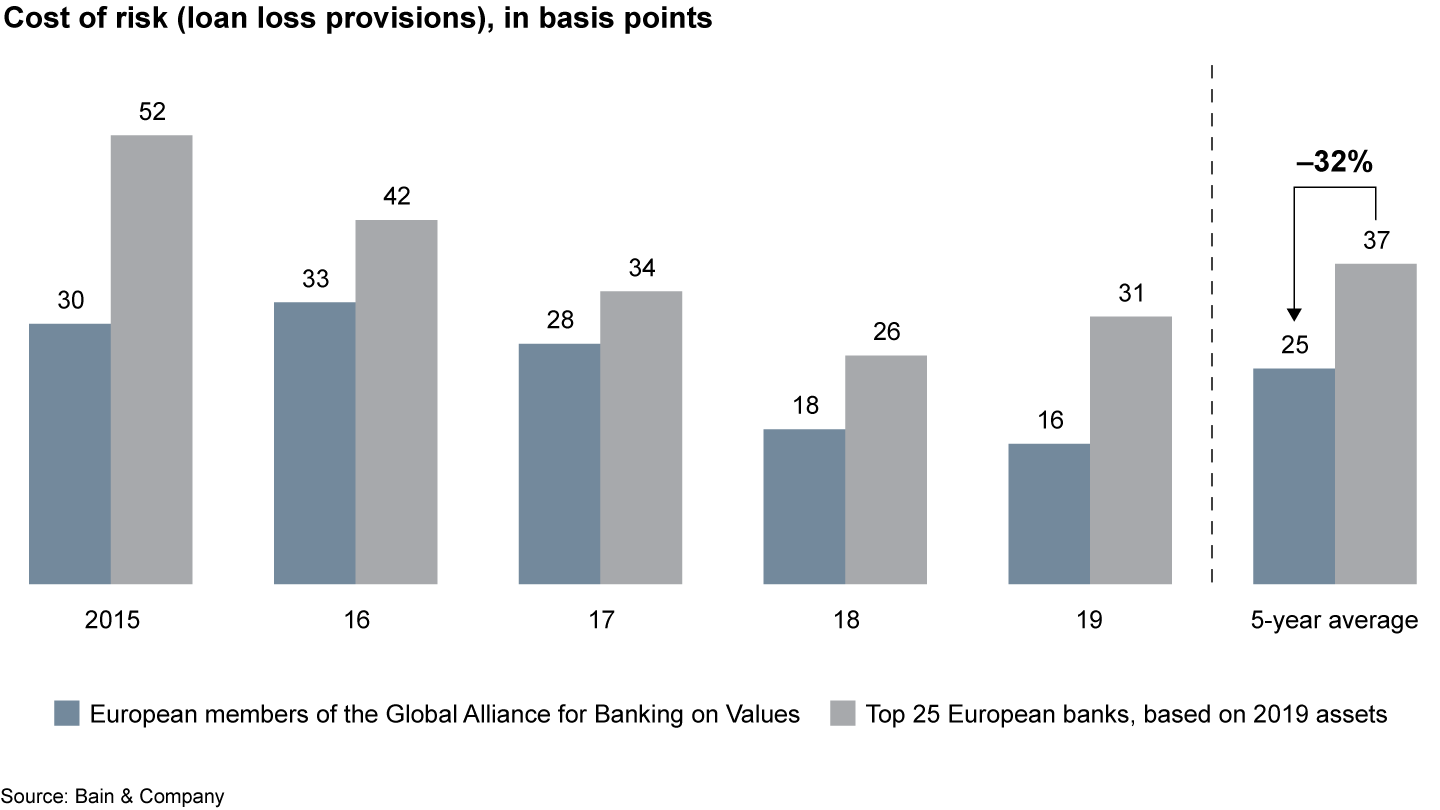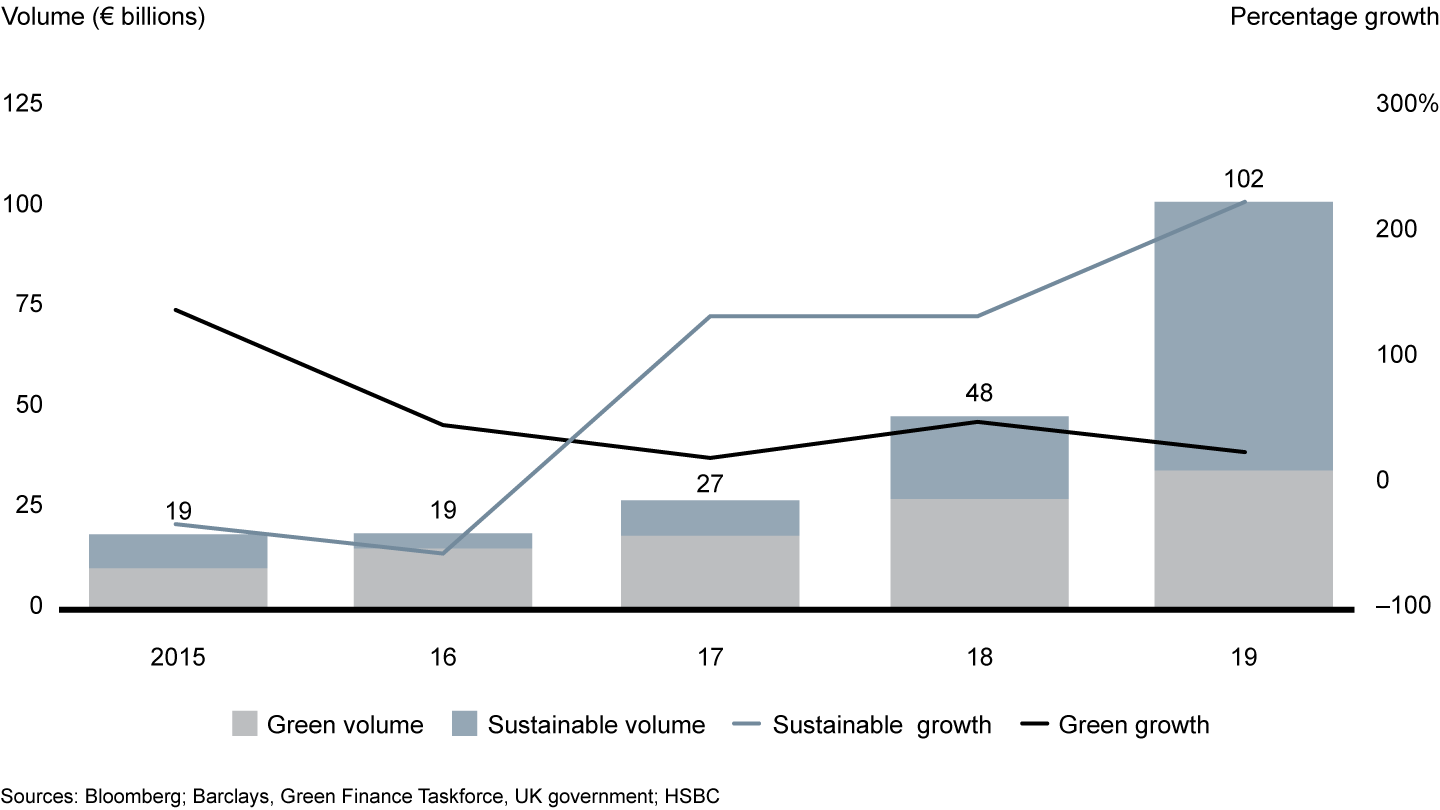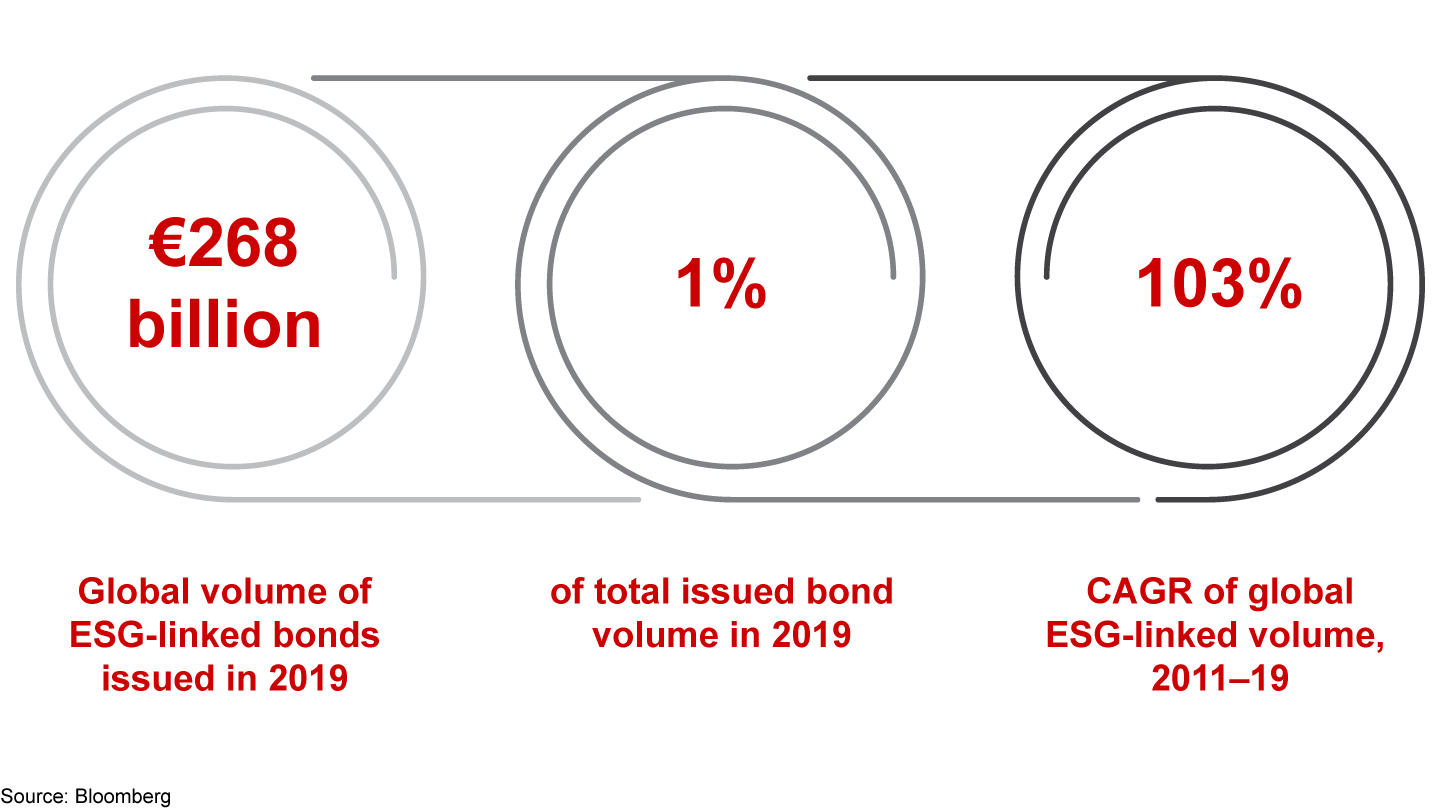Brief

Executive Summary
- Loans and bonds linked to ESG projects are soaring. While Europe is in the forefront, the trend has caught on in other regions as well.
- Banks pursuing this business may have higher costs of diligence and reporting, but those are offset by a lower cost of risk—32% lower over five years in Bain’s new analysis of European banks.
- Evidence is mounting that sustainable finance does not hurt the return on assets for banks, and it earns stronger customer loyalty.
- To thrive in this area, banks need to develop products that suit the specific client segment, along with advisory services to help clients succeed and a comprehensive customer experience.
Financing for projects tied to sustainability—covering a wide swath of environmental, social and governance (ESG) considerations―is enjoying rapid growth. The trend is most advanced in Europe, with other regions moving in the same direction.
Many banks pursuing the business of ESG-linked loans and bonds have discovered that they do not face a financial trade-off. New analysis by Bain & Company shows that the higher costs of diligence and reporting are offset by a lower cost of risk: European members of the Global Alliance for Banking on Values had a five-year average cost of risk of 25 basis points, 32% lower than the top 25 European banks by assets in 2019 (see Figure 1).


The time is ripe, as financing with an eye to ESG issues and not just financial returns has moved into the mainstream. HSBC, currently Europe’s second-largest financier of fossil fuels, recently broadened its ESG position by committing to reduce financed emissions from its portfolio to net zero by 2050 or sooner. The bank aims to provide between $750 billion and $1 trillion in sustainable finance by 2030.
Credit rating agencies increasingly consider sustainability issues in their assessments, and a growing number of financial institutions are integrating social and environmental impact in risk-return decisions. Some 190 banks and over 3,000 asset owners and managers have adopted United Nations sustainable banking and investing principles.
ESG-linked loans and bonds take off
ESG-linked loans are the fastest-growing segment of the corporate credit market (see Figure 2). Of the €102 billion issued in Europe during 2019, €35 billion consisted of green loans and €67 billion of other sustainability-linked loans. ESG loans typically include incentives for the borrower to reach ambitious, predetermined sustainability performance targets. ING and Philips, for example, were in 2017 the first to collaborate on revolving credit with the interest rate tied to a company’s sustainability performance.


Sustainable bonds’ size and growth globally have been even greater, with clients benefiting from lower bond yields (see Figure 3). The market has evolved as banks such as BBVA in Spain issued Covid-19–related bonds. Recently, the European Union’s first offering of social bonds drew orders of more than €233 billion, likely the biggest amount ever for any debt deal. The offering aims to provide funding for a job support program during the pandemic.


Clearly, investors and banks are seeing benefits from ESG finance instruments. The first benefit, a lower cost of risk, comes from lower loan loss provisions than with traditional loans. Managers at companies committed to ESG practices fight harder to avoid default. And environmental and operating risks often are lower than at companies exposed to traditional business—for instance, the risk of energy transition policies and other new regulations that could hurt unprepared firms.
Besides a lower cost of risk, evidence is building that sustainability has a positive influence on financial returns and profitability. At the very least, ESG-linked investments are not losing any degree of profitability or shareholder return for their efforts.
Another powerful benefit comes in the form of greater customer loyalty. In the Net Promoter ScoreSM comparisons we have undertaken, banks with a strong sustainability profile outperform their peers. Strong loyalty, in turn, correlates with higher customer lifetime value and a lower cost to serve.
Developing the portfolio
Building out a sustainable finance portfolio involves both transitioning loans already on the books and originating new loans. Here we focus on the latter, which takes a concerted effort in three areas.
Products that suit the customer segment. Loans that allow corporate clients to qualify for favorable terms must contain several elements: incentives that spur the client to attain the specified sustainability goals, covenants and key performance indicators to keep the client on track, and lean processes for monitoring and reporting progress.
Advisory services to help clients succeed. Most clients need expert advice to design and execute their ESG initiatives effectively. Relationship managers may still take the lead with a large enterprise client, but they will rely on ESG specialists who know the ESG offering in detail and can structure relatively simple operations. For complex transactions, banks should also set up a central ESG desk, rounding out an ESG center of excellence.
Banks should consider at least a couple tiers of offerings. They will serve large corporate enterprises with tailor-made loans along with advice. For small and medium-size clients, they will need a more standardized, digital solution. And banks can tap an ecosystem of partners to offer advice when warranted.
A comprehensive customer experience. Sustainable finance works best not as a standalone element within corporate banking, but rather as part of a comprehensive proposition that supports clients in their sustainable development and growth. Indeed, financing often represents the last step in the journey, after the bank has targeted likely clients, assessed their starting point and gaps, and collaborated to map out sustainable solutions (such as a plan for an auto supplier to transition to electric vehicles). The chosen initiatives are then made possible with credit.
Sustainable finance has the social and commercial momentum to keep expanding rapidly in nearly every industry sector. Banks that hesitate to establish a position now could find themselves shut out of this market in a few years. Those that accelerate investment stand to benefit by attracting the best clients, lowering their credit risk and building a reputation that will create a durable advantage.
Net Promoter®, NPS®, and the NPS-related emoticons are registered trademarks of Bain & Company, Inc., Satmetrix Systems, Inc., and Fred Reichheld. Net Promoter Score℠ and Net Promoter System℠ are service marks of Bain & Company, Inc., Satmetrix Systems, Inc., and Fred Reichheld.